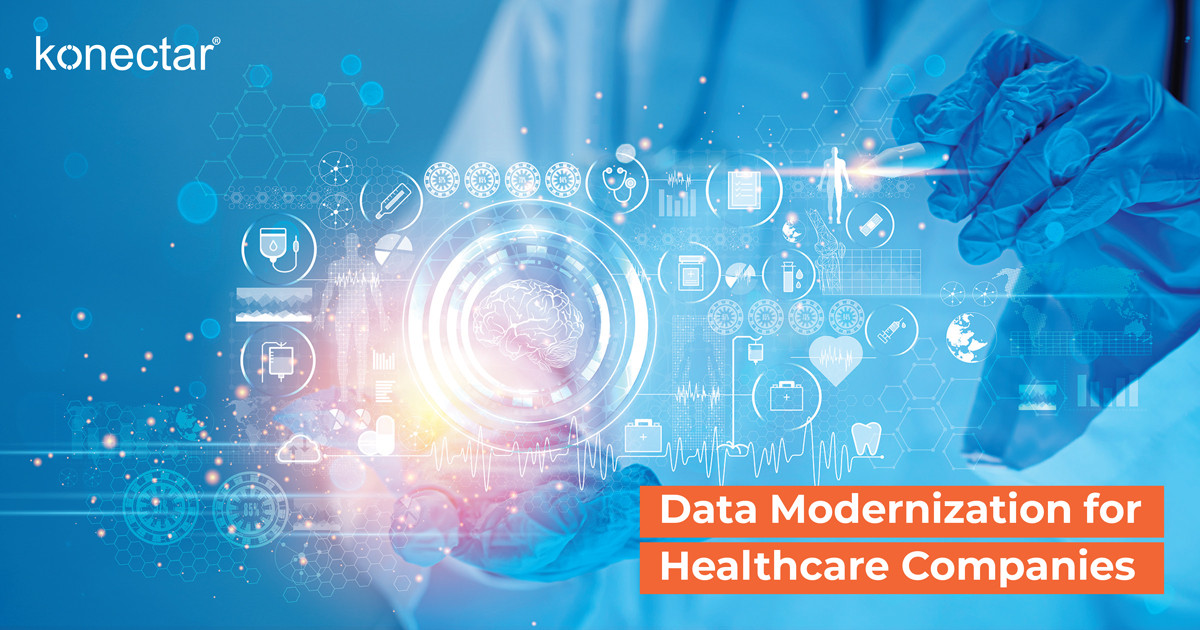Data modernization techniques leverage the power of advanced Machine Learning and Automation to transform how healthcare companies operate, extract insights to improve products or delivery of care, and manage resources. This shift towards data-driven processes is paving the way for improved healthcare outcomes, reduced costs, and enhanced operational efficiency. In this article, we will explore this concept and understand its applications.
What is Data Modernization?
Data modernization means shifting the organization's legacy data to modern databases that are scalable and compliant, offer storage of large volumes of data, and enable users to draw insights through analytics. It is like giving the legacy data a makeover so everything works well together. It helps create systems and processes to make a healthcare organization run more efficiently, boost the efficiency of products/services/healthcare delivery, and improve ROI.
While most sectors worldwide employ it, if we have to look at the statistics, then according to a study, healthcare and Life Sciences is the top sector leveraging the power of data modernization. This is followed by manufacturing, public sector, banking, and retail sector.
The Need for Modern Techniques
Let us understand this concept by considering the example of healthcare organizations. They deal with a multitude of unstructured data daily that originates from various sources such as appointment bookings, clinical notes, diagnostic devices, hospital admissions, and more. Studies show that the healthcare sector experiences a whopping 48% data growth annually.
Nevertheless, having abundant Data serves little purpose if healthcare organizations lack the necessary technology to harness its potential. The critical step for them is to transition to modern technologies. This will allow them to utilize the vast amount of data to gain practical insights
Handling this vast data to execute day-to-day tasks necessitates modern, sophisticated Software to ease data input, storage, and processing. EHR, telehealth, e-prescription, modern imaging and diagnostics tools, and more are the solutions that adeptly handle all these.
These modern tools offer easy information access, provide practical visualization tools, and encourage self-service analytics while upholding data governance principles. These advancements enhance healthcare comprehension and alleviate the burden on healthcare professionals.
Applications of Modern Data Techniques

-
Storage of Healthcare Records
Machine Learning techniques have great potential in simplifying recordkeeping in healthcare, particularly in Electronic Health Records (EHRs). It empowers healthcare providers to capture and document clinical notes more efficiently, thereby eliminating manual data entry processes.The application of AI thus not only holds the promise of enhancing patient care here, but it also offers the prospect of cost reduction in healthcare administration while streamlining operational efficiency.
-
Enhancing Medical Imaging Diagnosis
The high-resolution images generated by modern medical imaging technologies, like CAT scans and MRIs, have made it easy for radiologists and pathologists to get into every detail of the disease. However, analyzing these vast amounts of data can be a complex task for even experienced professionals.
Machine learning in this context has aided clinical experts in boosting their efficiency and accuracy. Some examples include identifying conditions such as COVID-19 and cardiovascular irregularities, detecting musculoskeletal injuries, and screening for various types of cancers.
-
Optimizing Manufacturing Processes
According to a study, approximately 95% of life sciences companies possess abundant operational data, which could help them achieve their performance objectives. However, two out of every three of these organizations struggle to make the most of this data. This challenge stems from issues related to data accessibility, data quality, and its fragmented nature.
The implementation of edge computing offers pharmaceutical manufacturers a solution to the problem of data integrity. Real-time data analysis, made possible by edge computing, empowers on-site operators to make quick and well-informed decisions. For instance, a temperature alarm is triggered during the manufacturing process if a mixing error occurs.
If a machine maintenance issue arises, it could lead to a failed validation result. These immediate alerts enable operators to take action. The right platform thus allows any operator to approach any asset and receive an instant performance report.
-
Mitigating fraud in the Health Insurance Sector
Healthcare fraud is a significant concern in the United States, with costs ranging from $68 billion to $230 billion annually. Claims investigators use predictive analytics to scrutinize unstructured data, including social media content, to identify specific claims for further review.
The incorporation of machine learning takes this a step further, allowing insurers to monitor such behavior over time and establish new protocols as fraudulent patterns emerge.
Furthermore, AI and machine learning contribute to the identification of fraudulent billing practices and highlight problematic accounts or providers consistently providing inaccurate information. This technology empowers insurance companies to identify and combat fraudulent activities within the system more effectively.
-
What is data modernization?
Data modernization involves updating and optimizing data systems and processes to make data more accessible, efficient, and valuable for an organization.
-
What are the benefits of data modernization?
Data modernization improves data quality, better insights, enhanced efficiency, and increased competitiveness in whichever sector it is implemented.
-
How do you modernize data?
Data modernization involves migrating legacy data to modern platforms, adopting cloud technologies, and implementing advanced Data Analytics tools.
-
What is public health data modernization?
Public health data modernization refers to updating data systems in the public health sector for better disease surveillance, reporting, and health management.
-
What is the Data Modernization Initiative (DMI)?
The Data Modernization Initiative is a program aimed at enhancing data capabilities and accessibility in government and public sectors.
-
What is the data modernization strategy for public health?
The strategy involves integrating data sources, adopting advanced analytics, and ensuring data interoperability to improve public health management.
By embracing data modernization, healthcare companies can gain deeper insights from the data they already have, enabling them to make informed decisions that enhance patient care outcomes. It is also beneficial in public health settings, such as - it could lead to improved disease tracking, faster response to health emergencies, enhanced resource allocation, and a more comprehensive understanding of population health trends. It also enables evidence-based policymaking and better healthcare service delivery.
Also in healthcare organizations, patient data is scattered across different sources, making it challenging to have a complete and unified overview of patients' health journeys. Therefore, achieving data interoperability is pivotal for delivering high-quality care, and the initial step in achieving this goal is data modernization.



